Consordinis articles are written by musicians who independently research, test, and recommend the best instruments and products. We are reader-supported. When you purchase through links in our articles, we may earn an affiliate commission.
In this article, we are reviewing the best pedalboard power supplies available in 2025. We’re looking at the most versatile, high-quality, durable, high-end, and budget power supplies for big and small pedalboards.
It’s super easy to practice in a rehearsal room with a couple of friends, and it’s even easier to jam along to your favorite tunes in your bedroom, regardless of how many pedals, effects, and modules you are using. However, the scene changes drastically when you hit the stage.
Many people are going against the grain rather than along with, hooking up all of their pedals with a daisy chain, and lo and behold, there’s smoke and electric crackling everywhere. You can always buy an adapter for each one of your pedals, but apart from the sheer fact that this will only complicate matters, you could just invest in a decent power supply unit.
That’s what we’re here to talk about today; many guitarists underestimate the importance of reliable power supplies, and that only leads to the fact that many people don’t have a clue what to look for when buying one. If you’re on the market searching for the best pedalboard power supplies, stick with us for a while longer.
Here are the best pedalboard power supplies:
1. Truetone 1 Spot Pro CS12
The most versatile pedalboard power supply
There’s no such thing as the perfect power supply for pedalboards, but the Truetone 1 Spot Pro CS12 is close for sure. It offers flexibility and reliability above all else, but it’s also a highly versatile power supply unit with numerous slots and a highly durable casing. It has its own flaws, but luckily none of them are major.
 Image credit: Truetone
Check Price on Amazon
Image credit: Truetone
Check Price on Amazon |
|
We’re starting off our review of the best pedalboard power supplies with the 1 Spot Pro CS12 from Truetone. This is, essentially, the most versatile high-end power supply that offers unparalleled reliability and top-shelf features. Although it’s not the most expensive model on the list, its performance has raised the bar for boutique power supplies for pedalboards.
There are several reasons why the 1 Spot Pro CS12 is one of the finest pedalboard power supply models out there – it features a total of 12 outlets for the variable, 9 V, and 18 V pedals; it’s neither too big nor too small, and it packs an amazingly built housing. To top it all off, it’s remarkably light, which is not the first thing that would pop to your mind after seeing it.
First things first, the dimensions of the 1 Spot Pro CS12 measure 10 inches by 10 inches by 2 inches, and it weighs 3.79 pounds. When compared to normal power supplies for pedalboards it might appear as big and bulky, but given the fact that it features 12 isolated outlets, it’s actually pretty small.
Speaking of which, the Truetone 1 Spot Pro CS12 comes outfitted with two 18 V outlets, four 9 V outlets, a single 9 V AC outlet, four multi-use 9 V/12 V outlets, and a single variable 4 V – 9 V outlet. Basically, you’ll have enough slots for a couple of dozens of pedals, plus some extras for heavy-duty high-consumption ones.
What we also found as convenient is that all outlet slots feature detailed descriptions above them, which is not something all power supplies have. The slots are organized in groups of four while the standalone outlets are on the sides.
Furthermore, the Truetone 1 Spot Pro CS12 features convenient threaded holes that will allow you to use mounting brackets with it; even though the bundle doesn’t contain the brackets, the sheer fact that you can use them is still a big plus.
2. Friedman Power Grid 10
A boutique-quality power supply
Friedman’s gear is popular and expensive for a reason. Their amps, pedals, and accessories are in a league of their own when it comes to performance, and the Power Grid 10 is an excellent example of their craftsmanship and ingenuity. We recommend this power supply unit to people who can afford to spend a good portion of an average salary and who demand top-notch performance in turn.
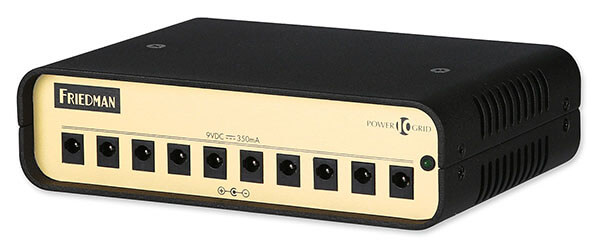 Image credit: Friedman
Check Price on Amazon
Image credit: Friedman
Check Price on Amazon |
|
If you value reliability and availability above all else and you don’t mind paying top dollar, we strongly recommend going with the Power Grid 10 from Friedman Amplification. Friedman’s power supply station boasts a uniquely designed casing, universal power connection type, and ten fully isolated output slots for 9 V pedals exclusively.
Arguably the most unique feature of the Power Grid 10 is the design of its top side; the sleek top surface can actually double as a ‘backup’ pedalboard where you can store spare pedals or the one that you wouldn’t normally be able to fit on your main pedalboard.
In terms of size, the Power Grid 10 measure 12 inches by 3 inches by 7 inches, and it weighs approximately 2.5 pounds. It’s obviously a bit lighter and smaller in comparison to our top pick, so if you’re struggling for space already, this might be a bit better solution for you.
This power supply was designed for 9 V pedals exclusively; it features ten 9 V DC isolated outlets, which is both a pro and a downside. The abundance of pedal connection slots is great, but the fact that only 9 V outs are available somewhat diminishes the versatility of this model.
Furthermore, the Power Grid 10 power supply unit comes in a bundle; you’ll receive a variety of cables that you can use to connect all your pedals in a single setup. If you’re already set in this field, these cables are sure to come in handy as replacements and backups. The cables included in the Power Grid 10 package include two 2.1 mm to 2.5 mm connectors, ten 2.1 mm black-to-black connectors, and two 20-inch long cables.
Lastly, we should mention that this is a boutique power supply unit. The Friedman Power Grid 10 is among the most expensive models available on the market, but it offers unparalleled reliability and a plethora of unique features to compensate for it.
3. Cioks DC7
The DC7 is a steal if you already own a Cioks-made pedalboard, but even if you don’t it offers superb value for the cash. Not many power supply units feature power toggle buttons, and even fewer units offer 15 V DC and 18 V DC connectivity. It is fairly expensive, though.
 Image credit: Cioks
Check Price on Amazon
Image credit: Cioks
Check Price on Amazon |
|
While Truetone and Friedman are both popular brands, not as many musicians have heard about Cioks. Be it as it may, this company has manufactured one of the best-rounded compact power supply units available under the name DC7.
Essentially, this power supply is drastically different from our previous picks; it’s much smaller, it has fewer connection slots, and it was designed to work with virtually all pedals regardless of their voltage.
What makes this power supply unit so exquisite is the fact that it’s basically a 3-inch cube that weighs just above a pound while being outfitted with seven different pedalboard slots. Now, this is also what makes it suitable for certain types of pedalboards;
In short, it rocks a variable 9 V – 12 V slot, two 12 V slots, two 15 V DC slots, and two 18 V DC slots; this means that it isn’t entirely practical for pedalboards that feature mainly 9 V or 12 V pedals, but it’s an excellent complementary power supply – it’s ideally used as a booster for your main power supply.
Another cool feature of the DC7 is the ‘power on’ button; each connection slot features it, and you can use it to disperse the sum total of available power in a much more economical way.
The biggest downfall of the DC7 power supply is its eclectic design; although there are several usable connection slots, you only get a pair of each, which is fairly ‘modest’ for most pedalboards. On the upside, it is very light and compact, and it can easily fit atop an existing power supply. It also has a miniature footprint and shouldn’t present many issues regarding storage.
Additionally, the DC7 power supply sports a USB connection port that you can use to charge your smart devices while also providing reliable, isolated power to your pedals.
4. Voodoo Lab Pedal Power 2 Plus
Since 9 V is the standard for most pedal-makers, the Pedal Power 2 Plus has the upper hand over the other models in the series. It’s not too expensive, but it’s certainly pretty far away from being cheap. Its casing is sturdy, and it offers exceptional reliability and sturdiness. In a nutshell, there are better models that cost more, and maybe a handful that offers similar value for the money.
 Image credit: Voodoo Lab
Check Price on Amazon
Image credit: Voodoo Lab
Check Price on Amazon |
|
We’re following up with the Vodoo Lab Pedal Power 2 Plus, which is one of the currently most popular mid-range pedalboard power supply units available. In general, the Pedal Power 2 Plus is a neatly packaged workhorse that will be able to provide you with enough electric juice for up to eight different pedals, and although there are a couple of more versatile models in the series, this unit packs a bigger bang for the buck.
Speaking of which, there are several Pedal Power units, including the smaller 4X4 and ISO-5, and the overkill which is Mondo. The Pedal Power 2 Plus brings the best of all three worlds together in a robust, well-balanced package.
As we’ve mentioned earlier, the Pedal Power 2 Plus is an eight-slotted power supply meant for 9 V pedals. Two of the eight are SAG ports while the previous two are designed to accommodate 250 mA pedals. If you have a diverse pedalboard comprised of pedals made by multiple manufacturers, this might be the best option for you.
Alternatively, if you’re using both 9 and 12 V pedals, we recommend the Pedal Power 4X4 instead. Guitar players who have smaller rigs would find the compactness and portability of the ISO-5 model a bit more welcoming than the somewhat bulky Pedal Power 2 Plus; this is a big power supply unit meant for larger pedalboards.
Of course, you will also receive eight black connector cables, all of which are sturdy and reliable, which means that you no longer need to lean on your old daisy chain connection.
Now, the biggest downfall of the Pedal Power 2 Plus is that it only works at exactly 120 volts. This shouldn’t be too big of a deal if you’re living and gigging in the USA, but should your tours take you over to Europe or Asia you are going to need a transformer if you want to use the Pedal Power 2 Plus at all.
5. Accel FX Power Source 8
The FX Power Source 8 is versatile true to form, and even though it’s not one of the most compact power supply units, its well-roundedness and decent affordability have earned it a very attractive spot on our list. We recommend it for gigging and live touring musicians who value durability above compactness and convenience.
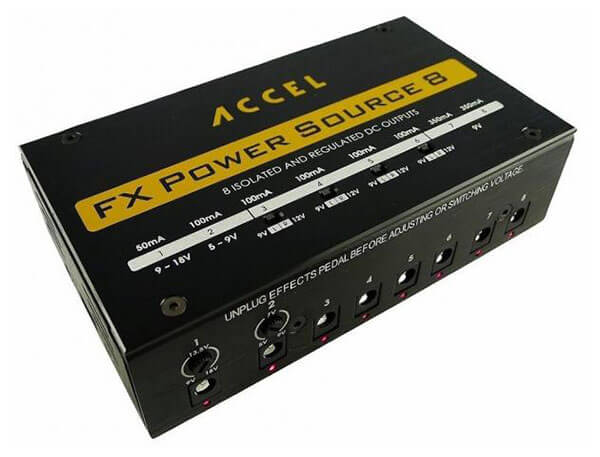 Image credit: Accel
Check Price on Amazon
Image credit: Accel
Check Price on Amazon |
|
The Accel FX Power Source 8 is a big roadworthy brick that boasts unparalleled durability. What makes it different from the other models we reviewed is the fact that it’s built to last and withstand decades of heavy touring, even though it may not be the most conveniently designed.
First of all, its dimensions measure 7.6 inches by 5.3 inches by 4 inches, and it weighs roughly 2.59 pounds. Obviously, it’s neither the biggest nor the heaviest power supply unit out there, but it’s not exactly compact either.
It features aircraft-grade aluminum construction on all of its sides, which basically makes it an impregnable fortress of sturdiness. It features mounting brackets that you can use to further simplify your cable management, and it offers eight fully isolated DC outputs.
What’s more, the FX Power Source 8 supports 9 V, 12 V, and 18 V pedals; moreover, you can convert the 12 V and 18 V slots to 9 V if you’re mainly using 9 V pedals.
Another pretty cool thing about the Accel FX Power Source 8 is that it’s actually a bundle comprised of a myriad of useful features, including three mounting screws, two DC converters, eight output cables, and a detachable AC in the cord. Last, but not least, every output socket features special over-voltage protection, ensuring that your rig is safe in case of a power outage, blackout, or power surge.
6. Joyo JP-04 Power Supply 4
We expected the Joyo Power Supply 4 to perform a bit worse than its pricier mid-range counterparts, but it held its own pretty nicely; in fact, its versatility and robustness are leagues above the scale. This might be a perfect choice for musicians who have some extra cash to spend, but who still don’t want to invest too much on a bulky, unwieldy power supply unit.
 Image credit: Joyo
Check Price on Amazon
Image credit: Joyo
Check Price on Amazon |
|
Here we are looking at the JP-04 Power Supply 4, which is a sturdy, reliable power box that offers eight isolated output jacks, compactness, ideal frequency range, universal connectivity, and a ton of other benefits at a very attractive price tag.
For comparison’s sake, let’s start off with its size; the dimensions of this power supply unit measure 6.29 inches by 3.93 inches by 2.36 inches and it weighs approximately 2.86 pounds. Although it’s pretty close to our previous pick (FX Power Source 8) in terms of weight, it’s fairly smaller and much easier to work with.
The Joyo JP-04 comes in a bundle, just like most high-quality power supply units do. The package contains eight DC connectors; two polarity-reversal cables, a single AC cord, and a neat little user’s manual that you can refer to if you have any questions regarding its performance.
In terms of design, the Power Supply 4 is convenient in the sense that it offers both portability and durability. It is made of robust aluminum material, and it can take quite a beating without giving in. If you’re a traveling musician, you’ll appreciate its smallish, nearly bulletproof-grade frame.
Like we’ve mentioned earlier, the JP-04 offers eight isolated connection sockets, including five 100 mA 9 V outputs, two 250 mA outputs, and a switchable 12 V / 18 V 100 mA output. Basically, this is a perfect power supply unit for people who have a one-sided pedalboard with a single wildcard they rely on every now and then.
We should also note that the JP-04 features a power on / off button; not every model has one, and it’s arguably one of the more rewarding features since it affords you a bit extra control over the power supply, especially on stage.
The only thing that we didn’t like so much about this power supply unit is that it doesn’t have any sort of cable management utility features.
7. Donner DP-3
In all fairness, there are maybe a couple of entry-level models that offer similar benefits to the Donner DP-3. It’s packed with a myriad of reliable features, and despite the few shortcomings in terms of its unwieldy design, it’s still one of the most valuable power supply units for pedalboards in this price range.
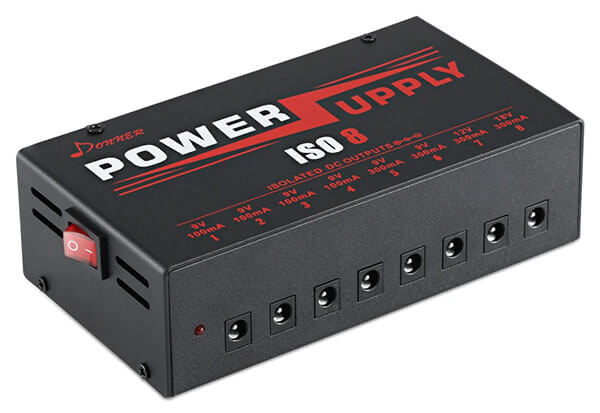 Image credit: Donner
Check Price on Amazon
Image credit: Donner
Check Price on Amazon |
|
We’re slowly jumping down the rabbit hole of budget pedalboard power supplies with the DP-3; essentially, Donner is one of the most popular brands that beginners and guitarists on a cash-strapped budget rely on the most.
The DP-3 is pretty simplistic in terms of design, and it’s actually packed with a variety of high-quality features. Let’s start off with its design. The DP-3 is pretty big; its dimensions measure 8.9 inches by 5.4 inches by 2.3 inches, and it weighs approximately 3.04 pounds.
Without any shadow of a doubt, the highlight feature of DP-3 is the toroidal transformer that boasts a built-in magnetic field shield, which provides exceptional protection against blackouts and power outages; this in turn ensures unparalleled reliability, regardless of the situation.
Furthermore, you’ll be able to use four 9 V 100 mA slots, two 9 V 300 mA slots, a single 12 V 300 mA slot, and a single 18 V 300 mA slot. Basically, it’s pretty convenient for most pedalboards, especially if you have a couple of pedals that consume a bit more power than usual.
As far as durability is concerned, DP-3 is much sturdier than an average budget PS unit. It features a case made of hard aluminum, so even though it’s not the most compact model its sturdiness compensates for it.
Donner’s bundle is packed with both necessities and complementary features; it is comprised of a power cable, eight DC cables, a single polarity-reversal cable, a 3.5mm converter, and a battery-clip converter.
8. MXR M237 DC Brick
There are many ways to describe the MXR DC Brick. Some would call it a cheap powerhouse that packs one hell of a punch for the buck; others praise the convenience it provides through a small but highly durable shell. However, the best way to address its attributes is to recognize that it possesses all of the aforementioned benefits. In a nutshell, this is a well-rounded power supply unit that is available at a very attractive price tag.
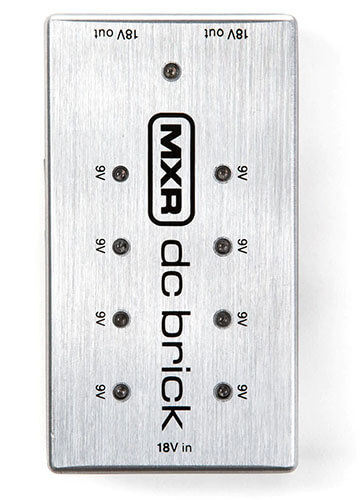 Image credit: MXR
Check Price on Amazon
Image credit: MXR
Check Price on Amazon |
|
Next on our list of the best pedalboard supplies in 2020 is MXR’s M237 DC Brick Power Supply. Most guitarists have heard of MXR, and some of their finest models are go-to rig pieces of seasoned veterans. The M237 is convenient for a number of reasons – it’s very affordable; it packs ten outputs in total, and it’s substantially smaller and lighter than average pedalboard power supplies.
Speaking of which, the dimensions of M237 DC Brick measure 9.2 inches by 4.3 inches by 2.7 inches, and it weighs only 1.55 pounds. It is roughly sized as an average effect pedal, which essentially means that it’s nearly half the size of a regular power supply unit.
Due to the small size and the product’s light weight, it is also much easier to pack and haul while on the road, which means it’s an absolute no-brainer pick for touring musicians. Moreover, M237 DC Brick is also supremely durable as it features a full-aluminum casing.
To top it all off, even the LED indicators are unexposed; this means that every little piece of the DC Brick will be safe, regardless of whether you’re towing it in a truck or in a pack. Speaking of indicators, these will shine if there’s any electricity-based problem with any of the ports; furthermore, each connection slot boasts top-grade magnetic-field shielding, so you won’t see the indicators sparkle a lot.
Just like we’ve briefly mentioned earlier, the M237 DC Brick features a total of 10 outputs. Eight of the ten are 9V slots, and there are two 18 V outputs on its left side. Additionally, there’s another 18V input slot on its right side as well.
As if these benefits weren’t enough, the M237 DC Brick is also very affordable. In fact, it’s one of the highest-value budget power supplies for the pedalboard that the current market has to offer.
However, there are a couple of bumps in the road that you might want to look into; namely, the DC Brick does not come with connector cables, so unless you already have enough, you’ll need to restock and resupply before hitting the stage.
9. SanJune ISP12
If you’re in a dire need of a lot of outlets and don’t have too much cash to spare, we strongly recommend the San June ISP12 power supply. It might be bigger than average, but it’s remarkably light and portable; to top it all off, it’s decently durable and it won’t fail you when you need it the most.
 Image credit: SanJune
Check Price on Amazon
Image credit: SanJune
Check Price on Amazon |
|
Most people use a couple of pedals while only a small number of guitarists utilize over six-seven pedals; now, if your pedalboard consists of 10+ pedals, you may want to take a look at what the SanJune guitar pedal power supply has to offer.
Essentially, ‘bigger is better’ applies here perfectly; this is a huge box that houses twelve DC outlets, including four 9 V 150 mA slots, four 9 V 500 mA slots, one variable 9/12 V 150 mA slot, two variable 9/12 V 350 mA slots, and a single SAG 150 mA slot. It has everything you need to run multiple pedalboards simultaneously.
Let’s switch gears a bit and talk about the size of the San June ISP12 pedalboard power supply unit; its dimensions measure 8.9 inches by 5 inches by 2.6 inches, and it’s surprisingly light with only 1.75 pounds of weight.
Although you may have a couple of problems finding enough space if you’re traveling in a van, the fact that it is as light as it goes a long way when it comes to moving it from place to place. Furthermore, this bundle contains twelve DC cables and a power adapter, making it an excellent choice for acts that are touring worldwide.
The top end of the San June ISP12 features a neat overlay of all of the functions; you’ll have a great reminder regarding the status of the LED indicators, the groupings of the output slots, and you’ll also be able to use the volt-SAG conversion toggle from here. Durability-wise, this San June model is pretty sturdy, but as you can imagine, it’s not as robust as some of the heavy-duty models we’ve covered so far.
10. Donner DP-1
The cheapest power supply that’s actually worth buying
This is arguably as far as dirt-cheap power supplies can go; the Donner DP-1 is a great tool that can come in handy in a pinch, and it’s actually a reliable power supply that can get you through a couple of legs of a bigger tour. Although you probably wouldn’t want to stick with it for life, it’s a great starting point for people who are fairly low on cash.
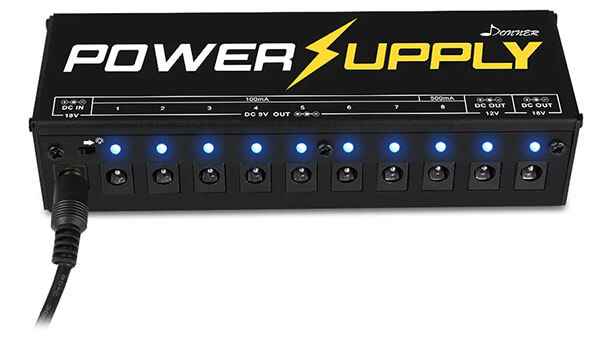 Image credit: Donner
Check Price on Amazon
Image credit: Donner
Check Price on Amazon |
|
Our final pick is the DP-1, the predecessor of the Donner DP-3. Basically, this is one of the cheapest pedalboard power supply units on the market that actually has some value to offer. It sports ten DC slots in total, and it’s by far the most compact and portable power supply in the price range.
The DP-1 weighs only 6.9 ounces and its dimensions measure 6.5 inches by 6.2 inches by 2.4 inches. It can literally fit in a larger pocket, and you’ll have no trouble packing it anywhere.
All of the output slots are fully isolated and sport short-circuit and over-current shielding. Speaking of which, there are seven 9 V 100 mA outputs, one 9 V 500 mA output, one 12 V DC output, and one 18 V DC output.
Versatility-wise, the DP-1 is fairly great. It can accommodate simpler rigs that use predominantly 9 V pedals, but it can also be useful for people with specialized pedalboards that are comprised of multi-amperage pedals.
As far as sturdiness is at stake, the DP-1 features a lightweight aluminum alloy construction, which makes it decently durable and exceptionally compact. It can’t exactly compare to big, robust cases such as the Truetone 1 Spot Pro CS12 or DC7 for example, but it’s sturdy enough to withstand rough roads.
This bundle also features ten complementary Moukey cables, although you’ll need to buy a power converter unit if you’re gigging anywhere outside of the USA. One of the most notable benefits this power supply unit brings to the table is affordability, as it is the cheapest model on our entire list while still possessing the qualities of much more expensive units.
The only drawback of it is that it doesn’t quite excel in any particular field of performance aside from affordability. It does have quite a bit of slots and ports, but most of them are for 9 V 100 mA pedals; it is small and light, but it’s not the sturdiest model on the market.
What to look for in pedalboard power supplies?
Almost every power supply unit looks differently, but sadly aesthetics are the least of your worries when you’re looking for a quality, reliable model. There are several factors that you’ll need to take into consideration, including build quality, the number of sockets, different types of voltage per socket, size, isolation, circuitry protection, and many more.
1. Isolation
Electrical power is different in terms of both quantity and quality in every venue, and that’s precisely why smart musicians take this factor seriously. This isn’t such a big deal most of the time, but if you’re unlucky your entire gig might get ruined.
‘Shifty’ power typically unbalances the electricity flowing between the pedals; ‘strong’ power often short-circuits the weaker pedals; ‘weak’ power leads to some pedals not even powering up. That’s where good isolation gets into the play.
Fully isolated slots pay little heed to the stability (or instability) of the power of the venue you are playing at; your pedals will get an equal and adequate amount of electricity, and more importantly, you’ll be able to guard your pedals against short-circuits, power outages, blackouts, and similar events that can potentially destroy your pedals for good.
2. Durability
You might fall for the aesthetic components of power supply units that ‘look’ sturdy, where in fact they may be flimsy and prone to damage. There are dozens of reasons why durability is one of the most important factors you should always keep in mind, so we’ll name a few.
First and most importantly, a flimsy power supply unit obviously won’t have the longevity required to survive more than a concert tour or two. Each model features delicate bits and pieces of hardware that are easy to break, and if the outer shell is not sturdy enough, you’ll just have wasted a couple of hundred dollars.
Secondly, durable power supplies are synonymous with reliable power supplies. Even if everything goes smoothly during the phase of unpacking and loading your gear, it’s not too difficult to imagine something getting out of hand, such as somebody dropping your unit (or dropping something on top of it).
Lastly, robust models are much easier to repair, especially if you own a boutique, expensive unit. The cost of repairs is usually easier to cover than buying a completely different unit altogether, not to mention that it’s easier to manage while you’re on a tour in locations you’ve probably never visited before.
3. Size and weight
Size plays a bit more important role than the weight of a power supply unit, but both are fairly important factors to consider. The size of the PS will determine how and where you will position it whereas its weight will determine how and where you will carry it. While compact, lightweight solutions are preferable most of the time, in this particular case bigger, heavier models are a bit better as they often offer a bit better protection and more durability.
4. Voltage
This is the point where things get a bit tricky; voltage requirements for different pedals are different, and having a power supply that can accommodate them all is recommendable. There are three standard voltage requirement types – 9 V, 12 V, and 18 V. Even though most pedals fall under the 9 V category, you don’t want to limit your arsenal of pedals for the future.
One of the best ways to ‘future-proof’ your pedalboard is to get a PS unit with variable voltage. Basically, if you know what you are looking for you should go with models that can accommodate your needs; if not, variable-voltage allows you to switch between 9 V, 12 V, and 18 V, which in turn will allow you to customize your rig differently for different occasions.
5. Worldwide Switching
Essentially, Worldwide Switching refers to the compatibility of the unit with different electric outlets. There are models with universal switching that will afford you the opportunity to plug them pretty much anywhere in the world, and there are models that are basically limited to certain areas (USA, Europe, Asia, and so on).
6. Budget
The most obvious, definitive factor is your budget. Luckily, there are power supplies that could accommodate everyone’s wallet, spanning from $50 to well above $200, so before anything else, decide on how much are you willing to spend on your new power supply unit.
Conclusion
Even though there are numerous brands offering different models of power supplies for pedalboards, the selection of the best-performing high-value models isn’t as huge. However, finding the best, most versatile, and most durable models is not an easy task as some would imagine.
We hope that you’ve liked our list of the best pedalboard power supplies, and we hope you’ll find what you’re after. Before diving into the reviews we strongly recommend that you check out the buying guide for additional information regarding the criteria we’ve used. We hope you’ve learned something new here and that you now feel more confident about making the purchase. Stay safe, folks!